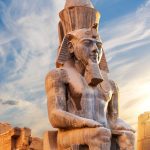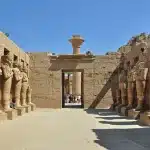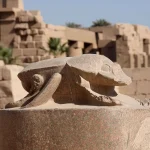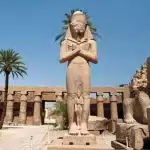About the Temple of Luxor
The Temple of Luxor is a wonderful example of the breathtaking building of ancient Egypt. The temple is considered an open architectural museum that was created throughout different period of the ancient Egyptian history. El Deak Tours offers the finest tours to explore all the monuments of Egypt in perfectly tailored travel packages.
Luxor Temple is the smaller sister of the Karnak Temple, located nearby. Both temples were connected with the Avenue of Sphinxes that was renovated and developed recently in an ambitious project carried out by the Egyptian government.
In fact, these two temples used to constitute of one unified temple where the Opet festival used to take place. This was when Amun, the king of gods, married his wife.
The history of the Temple of Luxor
Dedicated to the Holy triad of Thebes, Amun, Mut, and Khonsu, the Temple of Luxor was first established by Amenophis III in the middle of the 14th century BC. However, after this period, several Pharaohs and kings of Egypt added their own contribution to the temple, including Alexander the Great in the 3rd century BC.
The Temple of Luxor today
Numerous tourists who visit Egypt explore the wonders of the Temple of Luxor today as part of their travel packages to Egypt or the visits of their Nile cruises, sailing down the Nile from Luxor to Aswan, or the other way around.
The first features that grab the heart and the soul of visitors in the Temple of Luxor are the huge two black granite statues of Ramses II. They are among the largest and most impressive all over Egypt.
The first pylon of the Temple of Luxor dates back to the reign of Ramses II. This area documents the king defeating the Hittites in the battle of Kadesh. This is in addition to several other features.
Afterwards, there is the big courtyard with some of the finest pillars with distinctive papyrus shaped capitals also established by Ramses II. The reason behind the construction of this section is to reflect his powers and authority as one of the greatest kings of Egypt.
At the end of the corridor, afterwards, a couple of large statues of Ramses II stand as evidence of the greatness of the ancient Egyptian kingdom and its dominance in this era of history. Then, visitors find themselves inside the temple that Amenophis III inside the Luxor Temple. This is in fact the oldest part of the whole complex and has a significant importance from a historic point of view and perspective.
Afterwards, there is the section of the king Amenophis III. This was where the rituals of the Opet festival used to occur. There is a door in the walls built by the Romans that lead to the holy shrine of Amun. At the end of the Luxor Temple, there is the amazing section constructed by Alexander the Great who was keen to have his own touches in the temple.






0 Comment